| Article ID | Journal | Published Year | Pages | File Type |
|---|---|---|---|---|
| 1329875 | Journal of Solid State Chemistry | 2014 | 5 Pages |
•The crystal structure of the Ca2Gd2Ge2O9 was determined.•Gd3+ ion is distributed on two crystal sites with different occupation.•A structural study focused on the metal coordination polyhedra was performed.•Two emitting sites are detected for Eu3+ dopant ion in Ca2Gd2Ge2O9.•Strong red luminescence by excitation in the region where blue LEDs emit was found.
The new rare earth-based germanate compound Ca2Gd2Ge2O9 (orthorhombic (Pnma) crystal structure), has been characterized and investigated for the first time, using synchrotron powder X-ray diffraction. From Rietveld refinement calculations on the collected powder pattern we observe an inhomogeneous distribution of the two available cationic sites by Gd3+ and Ca2+ ions. In particular, the former prefers the occupation (67.5%) of the site with 8-fold coordination. In addition, we observed a not negligible degree of distortion of the Ge2O76− unit. Finally, luminescence spectra and decay curves of Eu3+ doped Ca2Gd2Ge2O9 were measured and analysed taking into account the structural features of the host. The results reveal that this material shows strong red luminescence upon excitation in the region where blue LEDs emit (470 nm).
Graphical abstractThe structural study on Ca2Gd2Ge2O9 exploiting synchrotron X-ray diffraction, allows us to determine the detailed geometry of the metal coordination polyhedra, which is closely related to the emission luminescence spectroscopy of the Eu3+ dopant ion introduced as impurity in this host.Figure optionsDownload full-size imageDownload as PowerPoint slide
